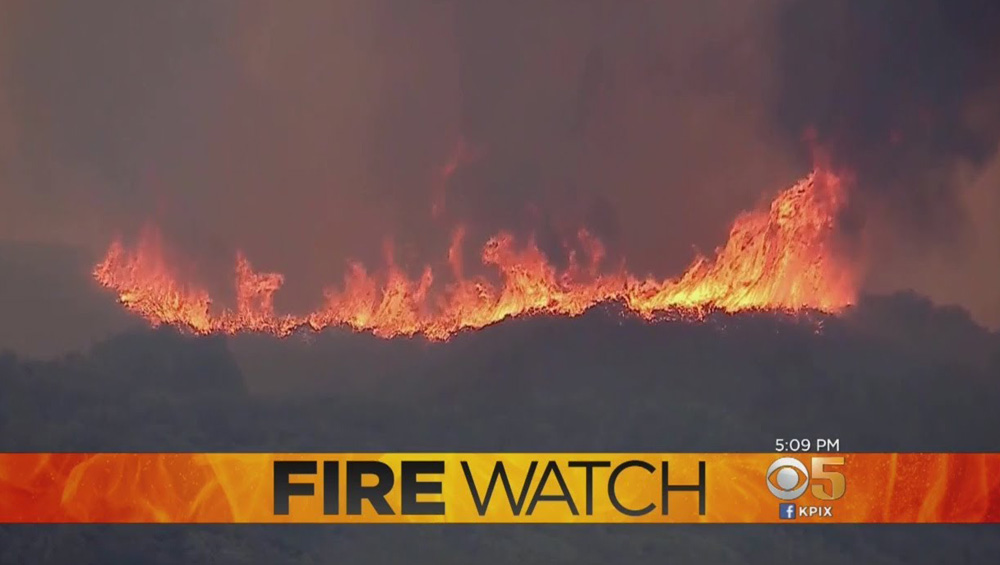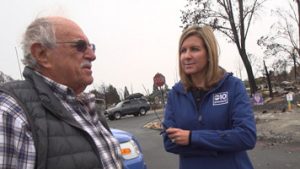
Fire Coverage Not Consumed With Climate Change

Even by California’s standards, the summer of 2018 has been a scorcher for wildfires. Three major fires — the Mendocino Complex Fire, Carr Fire and Holy Fire — have consumed almost 600,000 acres as of this writing and have remained fixed on the radar of broadcast meteorologists across the state.
But as those meteorologists continue their reporting on the fires, politically charged discussion of climate change is staying at the periphery of their coverage.
Meteorologists say that isn’t necessarily because they don’t believe in climate change or its potential man-made acceleration.
Rather, they say, it’s because they are far more focused on where the fire and smoke are and where they are going than on what’s causing them.
Plus, when they do find time for the why, other factors — including urbanization, tree-killing pests and winds — are presenting themselves as more definitive culprits in the short term.
Meteorology Vs. Climatology
Meteorologists are quick to draw the line where their discipline ends and climatology begins.
“In meteorology, we are not supposed to make a rule over something that has been happening in the last year,” says Lucrecia Borchardt, weather anchor at the Telemundo’s KSTS San Francisco.
Jeff Ranieri, chief meteorologist with NBC-owned KNTV San Francisco, agrees. “What we’re doing is weather, so we’re doing day-to-day changes in the atmosphere, where climatologists will study actual long-term patterns.”
Climatologists will study data over years, decades, centuries and more. They draw patterns spanning far longer than a broadcast meteorologist’s purview.
“Our first obligation is the next 24 hours — tonight, tomorrow and the next seven days,” says Fritz Coleman, chief meteorologist at KNBC Los Angeles. “The problem with daily local weathercasting is it doesn’t have an opportunity, mainly for time and clarity, to get into the macro.”
The on-air time constraints of 15-90-second hits inevitably curtail longer explanations, agrees Elaina Rusk, chief meteorologist at Scripps’ KERO Bakersfield. “I cover almanac data and how we are hotter than average every summer, but I don’t have the time to get into the scientific research on it on air.”
On social media, however, it’s a different story, he says. She says she can include links and research that often draws from NASA or the National Weather Service.
“I believe that the earth is warming. Whether that’s man-made or just a global warming pattern, I’m not completely confident in yet, but I share research from everything that I find to be trustworthy.”

KXTV’s Monica Gray
Monica Gray, chief meteorologist at Tegna-owned KXTV Sacramento, also turns to research from resources like Cal Fire and the U.S. National Forest Service to augment her reporting.
At its foundation, she says that reporting holds that the climate is always changing and man-made increases in the quantities of heat-trapping gases is a likely accelerant.
“I’m not a politician,” she says. “I’m not trying to enact different policies to change things. I’m just there to present what I’ve studied and know just as I would the forecast.”
The Immediacy Factor
A.J. Fox, chief meteorologist at Nexstar’s KGPE Fresno, says there are more pressing considerations than climate change when it comes to covering the wildfires.
“As a meteorologist, it’s not coming into my coverage at all because my coverage is on a day-to-day basis,” he says. “Because we’re right next to the wildfires, we’re more interested in the smoke and what it’s doing to us today versus climate change, which is something over years, decades or centuries.”
KNTV’s Ranieri agrees. “When it comes to the immediate fires, most people are concerned with what’s happening with the fire right now, which way is it burning and how is it affecting me.”
Tania Leal, a weather anchor with NBC-Telemundo’s KVEA Los Angeles, also concurs. “If it’s human-caused or it’s mother nature, it has been happening,” she says, “and we have a huge responsibility.”
That responsibility includes tracking the air quality affected by smoke. In Los Angeles, for instance, KNBC’s Coleman says that two-thirds of the viewing area has been affected by the Holy Fire alone.
To that end, KNBC and KNTV are among the NBC-owned stations using the new Storm Ranger mobile Doppler tool to track smoke levels in the atmosphere and warn viewers about its density.
Other Culprits
When discussing causes, the meteorologists point to the greater number of Californians living in fire-prone areas.
“If you look at the three big [fires], those are areas where 30 and 40 years ago people didn’t really live,” says Bill Martin, chief meteorologist at Fox O&O KTVU San Francisco. “So, what’s happening is when there are fires, they aren’t being allowed to burn.”
Martin, a sixth-generation Californian, joins a chorus of voices in the state calling for better forest management such as has been traditionally practiced in Yosemite National Park, where fires, such as those caused by lightning strikes, have in the past been allowed to burn.
Another accelerant has been the volume of available dead wood thanks to a one-two punch of drought and an epidemic of bark beetles. Some 129 million trees across California have been killed by both as of last December, littering the state with ample matchsticks for the wildfires to consume.
“Previously, if a wildfire happened it would kill a lot of smaller trees and the underbrush, but the larger trees would be damaged and live on and come back,” says KGPE’s Fox. “There are a lot of dead pine trees, oak trees and sequoias and they’re all available for kindling.”
And then there are the record temperatures. “We’re having an inordinately warm summer,” Coleman says. “In July we were six degrees above average for the entire month and we’re starting August the same way.
“We’ve got the heat and what might turn out to be a 30-year drought and a big pine die-off, so we’re at the confluence of some perfect elements here to cause these fire catastrophes.”
Add in the north-northeasterly winds that typically come in September and October and the fires could ratchet up even further, warns Stephen Paulson, a meteorologist with Fox-owned KTVU San Francisco. “We haven’t had that yet, which is kind of scary.”
All of which points to the wildfires staying at a fever pitch for the foreseeable future, a fact which Paulson says has uneasily settled into his daily job.
“It seems like all we talk about now is how hot it is and fire in the summer,” he said. “It never used to be like that.”
“Fire season used to be September through October,” says Paulson. “They were never year-round.”
For KNBC’s Coleman, a 35-year veteran, the fires are part of a bigger story. “In my daily work analyzing this and presenting it to people, I know there’s something going on.
“What people want to know about the weather is, for the love of God, do I need to have my child take their Hello Kitty raincoat tomorrow?” he says.
“If this pattern continues where things continue to be exacerbated from year-to-year and it looks like climate changes become part of people’s everyday lives, then we might be addressing it.”


































Comments (1)
Young Timer says:
August 16, 2018 at 10:23 am
I can see the conflict.
Local TV is limited to the “who, what, when, where and how” of the wildfires.
The WHY is left unexplained.
That dilemma is as predictable AS the weather.
Local TV weather forecasters are limited to just give the current conditions, where the rain is right now, how long it will take to get to and through the DMA, and where the next weather maker is. Nobody really cares about why weather conditions exist, that contribute to and enhance wildfires.
That stuff is usually relegated to The Weather Channel, whose viewing numbers sag greatly whenever the “why we have weather conditions that contribute to wildfires” are done usually in half-hour presentations.
Audiences won’t let local TV deal with that kind of information.